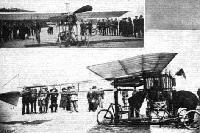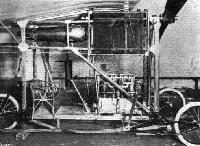
Описание
Страна: Великобритания
Год: 1909
Единственный экземпляр
A.Jackson Blackburn Aircraft since 1909 (Putnam)
The First Blackburn Monoplane
As might have been expected, Robert Blackburn's first aeroplane, being the product of a trained engineering mind, was no stick and string freak. Highly original in concept, it was a wire-and-kingpost braced high-wing monoplane built for strength rather than for economy in weight and in consequence was referred to in later years as the Heavy Type Monoplane to distinguish it from its successor. The parallel-chord square-cut mainplane was bolted across a wooden, wire-braced rectangular box structure which ran on three pneumatic-tyred, rubber-sprung wire wheels, the front being mounted on cantilevers whose trailing ends formed (as an additional safety measure) two long flat skids. A wicker chair from father's garden was pressed into service as a pilot's seat and was mounted on the floor of the box on runners as a means of C.G. adjustment. A 35 hp Green water-cooled engine (one of Gustavus Green's four-cylinder masterpieces and owing nothing to the firm of Thomas Green) was mounted on the floor ahead of the pilot and cooled by two side radiators under the wing. It drove a slow running 8 ft 6 in diameter airscrew of Blackburn's own make through a strong 2 to 1 roller chain and sprocket reduction gear. The overhead airscrew shaft ran in bearings at the front end of a long Warren girder boom which carried a fixed tailplane and, at the extreme end, a cruciform, all-moving, non-lifting, Santos Dumont type empennage mounted on a universal joint.
Not content to copy other experimenters, Blackburn dispensed with the feet for controlling direction, and fitted his patent 'triple steering column' consisting of a single car-type steering wheel which turned to operate the all-moving tail as a rudder, moved up and down when it functioned as an elevator and from side to side when warping the wings. He intended originally to fit his patented stability device in which a pendulum admitted air from an engine-driven compressor to one end or the other of a cylinder, according to which way the machine was banking, and an internal piston then operated the control surfaces so as to maintain straight and level flight. Although brilliantly anticipating the automatic pilot of the future, the device was not proceeded with and in any case would not have worked when the aeroplane was accelerating or decelerating.
The designs having been completed in Paris in 1908, the aircraft was built quite rapidly in the small workshop at Benson Street, Leeds, with the assistance of Harry Goodyear, and in April 1909, and in the face of much scepticism, Blackburn began his trials along the wide stretch of sand between Marske-by-the-Sea and Saltburn on the northeast Yorkshire coast. Painstaking taxying trials continued at intervals and the occasional absence of tyre marks proved that short hops were being made, but the 35 hp Green gave insufficient power for sustained flight and Blackburn dismissed these attempts as 'sand scratching'.
He had suspended such weighty items as engine, tanks and pilot, well below the mainplane in order to obtain a low C.G. position, but the disadvantages of such a pendulous arrangement were not immediately obvious and it was not until 24 May 1910 that he attempted a turn and paid the price. The aircraft sideslipped, dug in the port wing, skidded into a hole and threw the pilot from his seat.
One wing was a write-off, the airscrew broken and the undercarriage twisted and there was no alternative but to take the aeroplane back to Benson Street. There work began on an entirely new design and when the works moved to larger premises in Balm Road, Leeds, the fuselage of the First Monoplane went too. Illustrations in the company's 1911 catalogue show it being dismantled in stages at the end of 1910 during the overhaul of two Bleriot monoplanes for the Northern Automobile Co Ltd and the construction of Robert Blackburn's second monoplane. For no obvious reason it also received a two page descriptive write-up as the firm's new Military Type, increased in span and length and 'specially built for speed, with seating accommodation under the mainplanes and possessing thereby the chief advantage of the biplane - that of an unobstructed view'. The historic but undoubtedly defunct aircraft was then declared eminently suitable for warlike purposes!
Known as the '1909 Replica Group', enthusiastic Blackburn employees at the Brough works of Hawker Siddeley Aviation Ltd were preparing in 1966 to build a full-size replica for exhibition purposes.
SPECIFICATION AND DATA
Construction: By Robert Blackburn and Harry Goodyear at Benson Street, Leeds, Yorks.
Power Plant: One 35 hp Green
Dimensions:
(First Monoplane)
Span 24 ft 0 in Length 23 ft 0 in
Wing chord 6 ft 5 in Wing area 170 sq ft
(Military project) Span 30 ft 0 in Length 26 ft 0 in
Weights: All-up weight 800 lb
Performance: Estimated maximum speed 60 mph
Production: One aircraft only, completed September 1909, damaged beyond repair at Saltburn Sands 24 May 1910, dismantled at Balm Road, Leeds, about December 1910.
Описание:
- A.Jackson Blackburn Aircraft since 1909 (Putnam)
- M.Goodall, A.Tagg British Aircraft before the Great War (Schiffer)
- P.Lewis British Aircraft 1809-1914 (Putnam)
- Журнал Flight
Фотографии
-
M.Goodall, A.Tagg - British Aircraft before the Great War /Schiffer/
Blackburn's first monoplane was tested on the sands at Marske.
-
A.Jackson - Blackburn Aircraft since 1909 /Putnam/
Robert Blackburn's First Monoplane in the workshop at Marske-by-the-Sea where it was housed between attempts to fly from the nearby sands, 1909-10.
-
Журнал - Flight за 1910 г.
Front and side views of the Blackburn heavy type monoplane.
-
A.Jackson - Blackburn Aircraft since 1909 /Putnam/
Front view of the First Blackburn Monoplane on the sands at Marske in 1909.
-
Журнал - Flight за 1910 г.
View of the car beneath the planes on the Blackburn heavy type monoplane.
-
Журнал - Flight за 1910 г.
Two views of the Blackburn aeroplane control mechanism.
-
A.Jackson - Blackburn Aircraft since 1909 /Putnam/
The fuselage of the Second Monoplane under construction in the Benson Street works, with the partly dismantled First Monoplane behind.
-
Журнал - Flight за 1910 г.
Diagrammatic sketch of the Blackburn aeroplane control.
-
A.Jackson - Blackburn Aircraft since 1909 /Putnam/
First Blackburn Monoplane
-
P.Lewis - British Aircraft 1809-1914 /Putnam/
Blackburn Heavy Monoplane










